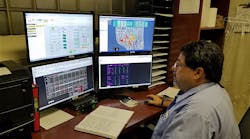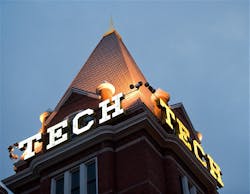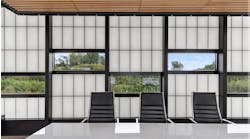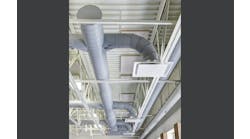Heating, ventilation and air conditioning accounts for about 37 percent of electricity use in U.S. educational facilities, according to U.S. Energy Information Administration data. That makes HVAC systems ripe for optimization: Schools and universities that upgrade their systems to run at peak efficiency can save hundreds of thousands, even a million dollars or more, on annual energy bills.
So why isn’t everyone doing it already? Two major reasons are uncertainty about results and cost accounting. Optimization can be daunting and involve equipment upgrades as well as an automated control solution. Facility managers aren’t going to find the money for that under the couch cushions. But many institutions have shownthat by carefully calculating return on investment (ROI) and managing projects strategically, optimization can deliver targeted results immediately and over time.
What is optimization?
Optimization means getting away from the philosophy of applying more energy to hide the symptoms of system deficiencies, and instead finding a way to deliver the most system output with the least system input. To deliver consistent, reliable savings, HVAC optimization requires three elements: measurement, a system-level approach and automatic control.
Measurement: Measuring both the energy input and the system output is essential for data-based optimization, because varying the energy input of any piece of equipment will vary the total system output.
System-level approach: A system-level approach is key to effective HVAC optimization because it prevents unintended side effects that may occur if you optimize components one by one. Without this holistic approach, reducing the output of one component may cause other components to increase their energy use.
Automatic control: A truly optimized system requires continuous, automatic control. Solutions that call for human intervention to carry out optimization may provide some energy savings, but real-time, dynamic control is the only way to provide maximum savings without compromising operations.
This kind of control is particularly important in a plant with a mix of old and new equipment from multiple manufacturers—a common situation for schools and universities. With mismatched equipment, it is not always clear which is the best combination to run or what is the best set point for a subsystem. HVAC optimization provides the information needed to control complex HVAC systems for the greatest efficiency and the control sequences that will best make use of that information.
Determining ROI for optimization
Certain facilities are more likely to meet ROI requirements than others. Consider a quick calculation of savings and ROI: If an HVAC optimization reduces campus energy use by 5 percent and the payback threshold for energy projects is three years, then the project budget for optimization is 15 percent of the campus’s annual energy expenditure.
Consider cost factors. The condition and age of the HVAC system will affect both the cost and the savings potential of an optimization. The older and less controlled an HVAC system, the larger the potential savings, but the potential cost to bring the system to optimization readiness also is larger. The newer and more modern an HVAC system, the lower the cost and the potential savings.
The size and nature of an HVAC system also affects costs. Larger and more centralized systems concentrate energy use in one place, where it’s easier to measure and optimize. A distributed system, such as one with numerous split-systems or rooftop DX units, will require optimization and monitoring of each independent system and thus will cost more to optimize.
An HVAC system at the end of its life provides a great opportunity for optimization. If a system is ready for retirement, optimization along with equipment replacement provides a quantifiable financial payback that would not otherwise exist. Replacing and optimizing a new chiller may have a 10- to 15-year payback, but replacing the chiller with no optimization may have a longer payback or none at all.
Coordinate with capital improvements for cost-effectiveness. If a large capital improvement is already planned, it makes sense to look at HVAC optimization, especially if the HVAC system is part of the renovation. You may be able to consolidate construction costs. A design review from a qualified optimization provider may reduce project costs if it finds unnecessary or redundant equipment. A common example is primary/secondary chilled water pumping: the HVAC optimization system may be able to achieve greater efficiency with a primary-only chilled water pumping arrangement, and converting the system to primary-only during the design phase eliminates the need to purchase and install a whole set of pumps.
Elements of a successful optimization project
A significant number of energy conservation projects fail to provide the energy or cost savings that were projected. Facility managers can reduce that risk with optimization projects by following a robust process from concept to design, bidding, construction and after-project support.
Defined goals: Is the goal to reduce energy costs as an absolute value, or energy cost per square foot, or energy input per unit output? When reducing energy costs, what is the baseline against which energy use will be compared? Answering these questions will ensure that the project has the right targets.
Measurement and verification (M&V): The optimization product should include an M&V method that can report on the effectiveness of optimization versus the organization’s goals. If the organization has a carbon footprint reduction goal, for example, the product should report mass of CO2reduced in an easy-to-retrieve format.
Road map: A robust road map will have projected energy savings, an M&V plan, and a detailed plan of the project retrofits and tasks required for optimization. The savings projections and retrofit plan should be developed in partnership with the contractors who will do the work.
Training: As with HVAC controls, HVAC optimization can easily be overridden or bypassed by operators and thus fail to meet savings goals. Proper training will be needed to give operators an understanding of how the system is meant to work, what to expect the system to do, and how to respond to a problem.
With all these elements in place, HVAC optimization will result in excellent system performance and energy savings year after year.
Woo, PE, is manager, engineering at Optimum Energy. He has worked on university optimization projects in California, Georgia, Maryland, Missouri, and Texas, and he manages a team of engineers with extensive experience in the higher education space.
Georgia Tech HVAC optimization reaps savings and insights
In 2016, Georgia Institute of Technology received a $7.7 million loan from the state to tackle energy and water conservation projects—as long as the project could pay for itself within seven years. Donald P. Alexander, Georgia Tech’s facilities design and construction institute engineer, determined that improving the efficiency of the university’s two chiller plants would provide the greatest benefit.
Optimum Energy performed an investment-grade audit and scoped a comprehensive plan that included equipment upgrades and reconfiguration as well as installation of advanced control software.
“This project gave us the opportunity to make a radical change to our chiller plant operations that would benefit the entire campus,” says Alexander. Plus, the loan ROI was guaranteed.
Solution: state-of-the-art efficiency and dynamic control
The project team replaced two old chillers with one larger, state-of-the-art chiller that could handle wide variations in water flow. Other mechanical upgrades included installing variable frequency drives on one chiller and all condenser water pumps and cooling tower fans (26 motors in total).
The project team also boosted pumping efficiency by changing from a primary/secondary pump system to variable primary pumping. The new configuration not only reduces the plants’ energy usage significantly, but also saves water.
The control system dynamically adjusts chillers in response to external conditions and plant operations. Now Alexander and his team, along with Optimum engineers, can see and evaluate system performance in real time.
Result: energy consumption drops by a third
On the first day, the plants’ energy consumption dropped from 1.0 KW/ton of cooling to 0.65 KW/ton across the combined 28,152 tons of cooling capacity.
After nine months, the project is on track to save more than $1.5 million a year in utility costs and nearly $272,000 in operational costs. It is also expected to cut campus energy consumption by 17.5 million kilowatt hours—more than a third—and save 31 million pounds of CO2emissions per year.
“By keeping the equipment operating at maximum efficiency, we’re saving money—and that’s what the optimization project is really about,” says Alexander. “I expect the plants to continue to improve and perform at a more efficient level than today. As we add more research buildings, we’ll need more chilled water capacity—we’ll definitely start off with optimization.



